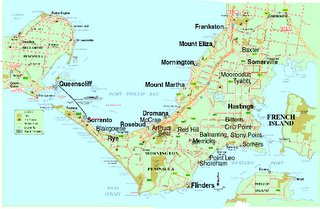 The importance of Victoria’s Mornington Peninsula to the history of wine in Australia may seen quite insignificant. After all the region does not rate a mention in the indexes of W S Benwell’s Journey to Wine in Victoria or David Dunstan’s Better than Pommard: A History of Wine in Victoria. But like many regions near the capital cities of most states of Australia there is a long association with vines and wines. Dunstan notes on page 73 that at a meeting of the Melbourne Vine Grower’s Association in August 1867 wines were exhibited from Dromana. However the modern era of wine history of the Morington Peninsula began in the 1950’s when experimental planting were made at, where else, Dromana. This small planting was purchased by the brother-in-law of wine merchant Doug Seabrook, and Seabrook experimented with plantings of Rhine Riesling until the vineyard was destroyed by bushfire in 1967 (see John Beeston, A Concise History of Australian Wine). In the 1970’s business man Baillieu Myer planted cabernet and riesling at the family property Elgee Park. Myer was followed by Nat White who planted at Main Ridge in 1975, and the Kefford’s planted Merricks North in 1976 (see John Beeston, The Wine regions of Australia).
The importance of Victoria’s Mornington Peninsula to the history of wine in Australia may seen quite insignificant. After all the region does not rate a mention in the indexes of W S Benwell’s Journey to Wine in Victoria or David Dunstan’s Better than Pommard: A History of Wine in Victoria. But like many regions near the capital cities of most states of Australia there is a long association with vines and wines. Dunstan notes on page 73 that at a meeting of the Melbourne Vine Grower’s Association in August 1867 wines were exhibited from Dromana. However the modern era of wine history of the Morington Peninsula began in the 1950’s when experimental planting were made at, where else, Dromana. This small planting was purchased by the brother-in-law of wine merchant Doug Seabrook, and Seabrook experimented with plantings of Rhine Riesling until the vineyard was destroyed by bushfire in 1967 (see John Beeston, A Concise History of Australian Wine). In the 1970’s business man Baillieu Myer planted cabernet and riesling at the family property Elgee Park. Myer was followed by Nat White who planted at Main Ridge in 1975, and the Kefford’s planted Merricks North in 1976 (see John Beeston, The Wine regions of Australia).The Mornington Peninsula wine region is about 60 km south and south east of Melbourne (see map). The region has a maritime climate which is heavily influenced by the wet and windy weather of Bass Strait. Altitude ranges from sea level to 250 meters. These features produce cool climate vineyard country with grape ripening depending upon both altitude and wind exposure. The most successful varieties are Chardonnay and Pinot Noir. However Shiraz has been successful in the warmer areas. Cabernet has been produced but has fallen from favor. Pinot Gris is thought to have a future on the Peninsula.
No comments:
Post a Comment